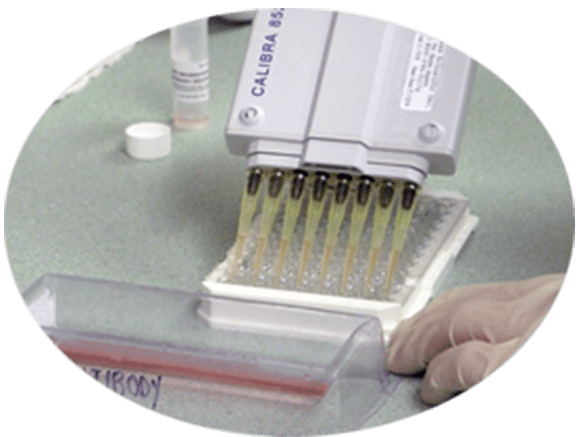Services
Cyanotoxin / Algal Toxin Analysis
Don’t know which method to choose? Begin with our description of services to better understand what information each test provides.
For water samples, we recommend the following methods for the most commonly reported cyanotoxins. Please contact us for pricing.
| Algal Toxin | Recommended Method |
|---|---|
| Microcystins / Nodularins | Adda ELISA | Cylindrospermopsin | LC-MS/MS | Anatoxin-a | LC-MS/MS | Saxitoxins | ELISA |
Below, you can find more information on the different tests we offer by both ELISA and HPLC methods, with detection limits for water samples. All analyses are conducted by professionals in the field of chemistry with rigorous QA/QC.
ELISA
(Enzyme linked immunosorbent assay)

ELISAs are very popular screening assays that provide limited quantitative information for specific groups of cyanotoxins. ELISAs typically have the ability to detect toxins at low levels for both surface and drinking waters.
It should be noted that ELISAs are also prone to sample matrix interference that may confound results, leading to erroneous conclusions. It is important to verify any positive ELISA responses with other techniques, such as HPLC coupled with PDA, FL or MS.
Algal Toxins analyzed with ELISA:
| Algal Toxin | Reporting Limit ng/mL (ppb) |
Method |
|---|---|---|
| Microcystins / Nodularins | MRL = 0.30 ppb | Adda ELISA (Method 546 & Standard Methods 10110) |
| Cylindrospermopsin | MRL = 0.10 ppb | Cylindrospermopsin (522011) |
| Saxitoxin | MRL = 0.05 ppb | STX specific assay (52255B) |
| Brevetoxin (NSP) | MRL = 0.25 ppb | Brevetoxin specific assay (MarbioNC Assay) |
| Guanitoxin (previously known as anatoxin-a(s)) | qualitative screen | Organophosphate / Carbamate specific assay (550051) |
LC - MS/MS
Liquid Chromatography – Mass Spectrometry/Mass Spectrometry
GreenWater Laboratories / CyanoLab currently maintains and operates multiple high performance liquid chromatography (HPLC) systems with photodiode array (PDA), fluorescence (FL), and tandem mass spectrometry (MS/MS) detection. This provides us the ability to report data with a high level of confidence as well as the ability to supply confirmatory analysis on ELISA data.
| Algal Toxin | Method Detection Limits | Method |
|---|---|---|
| Microcystins / Nodularin Suite (14+ congeners) | MDLs = 0.1 ppb | Foss et al. 2020, Foss & Aubel 2015 |
| Total Microcystins (MMPB) | MDL = 0.1 ppb | Standard Methods 10110 |
| Cylindrospermopsin Suite | MDL = 0.1 ppb | Foss & Aubel 2013 |
| Anatoxin-a Suite | MDLs = 0.1 ppb | Foss et al. 2018 |
| Method 545 (Anatoxin-a/Cylindrospermopsin) | MRLs = 0.1 / 0.1 ppb | Method 545 |
| Saxitoxins (13+ analogs) | MDLs = 0.1-0.5 ppb | Yilmaz et al. 2018 |
| BMAA (includes BAMA, 2,4-DAB, 3,4-DAB & AEG) | MDLs = 5 -10 ppb | Foss et al. 2018 |
| Domoic Acid | MDL = 0.5 - 1.0 ppb | In House LC-MS/MS |
| Dermatoxins (lyngbyatoxin-A, aplysiatoxins) | MDLs = 0.5-5 ppb | In House LC-MS/MS |
| Okadaic Acid & Dinophysistoxins 1 & 2 | MDLs = 0.5-2 ppb | In House LC-MS/MS |
| Brevetoxins (PbTx 2 & 3) | MDLs = 0.5-2 ppb | In House LC-MS/MS |
Method Detection Limits and Reporting Limits
Method Detection/Reporting Limits (MDLs & MRLs) are based on water samples and may vary depending on spike (standard addition, LFSMs) returns. Our reports reflect the impact of matrix on results through internal standard and LFSM returns, as well as providing interpretations as needed.
Rapid Turnaround Times (Rapid TATs)
Rapid turnaround times are available on most toxin analyses conducted on water samples. Please call for rapid TAT requests.
Complex Matrices
GreenWater Laboratories conducts cyanotoxin analyses on many different biological matrices, including tissues and food products.
For more information on analyzing biological matrices, click here.
Additional extraction charges do apply to complicated matrices. Please contact us with specific requests.
